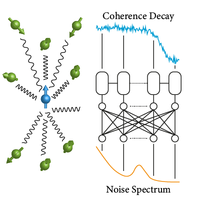Abstract
Understanding the spectrum of noise acting on a qubit can yield valuable information about its environment, and crucially underpins the optimization of dynamical decoupling protocols that can mitigate such noise. However, extracting accurate noise spectra from typical time-dynamics measurements on qubits is intractable using standard methods. Here, we propose to address this challenge using deep-learning algorithms, leveraging the remarkable progress made in the field of image recognition, natural language processing, and more recently, structured data. We demonstrate a neural-network-based methodology that allows for extraction of the noise spectrum associated with any qubit surrounded by an arbitrary bath, with significantly greater accuracy than the current methods of choice. The technique requires only a two-pulse echo decay curve as input data and can further be extended either for constructing customized optimal dynamical decoupling protocols or for obtaining critical qubit attributes such as its proximity to the sample surface. Our results can be applied to a wide range of qubit platforms, and provide a framework for improving qubit performance with applications not only in quantum computing and nanoscale sensing but also in material characterization techniques such as magnetic resonance.
3 More- Received 3 May 2020
- Revised 11 December 2020
- Accepted 7 January 2021
DOI:https://doi.org/10.1103/PRXQuantum.2.010316
Published by the American Physical Society under the terms of the Creative Commons Attribution 4.0 International license. Further distribution of this work must maintain attribution to the author(s) and the published article's title, journal citation, and DOI.
Published by the American Physical Society
Physics Subject Headings (PhySH)
Popular Summary
Understanding the environment surrounding quantum systems is key to being able to use them as quantum sensors or qubits, but doing so accurately is challenging using traditional mathematical and experimental techniques. Our results show how machine-learning techniques and specifically neural networks can be used to infer the qubit environment accurately using only simple and readily performed experimental measurements. This is important because it allows the design of bespoke control sequences to protect fragile quantum states from their particular environments for much longer than would otherwise be the case.
Once the specific nature of the qubit environment is known, then it is straightforward to predict how a qubit will evolve over its lifetime. However, it is challenging to do the reverse: to deduce the environment from a measurement of the qubit. By simulating a series of real-world noise environments and the qubit evolution we are able to teach a neural network how the evolution measurement corresponds to its noise environment. This enables the network to successfully predict the noise environment of a new qubit using only a simple measurement of its evolution, which is readily performed in the lab. We use similar techniques to erase unsystematic experimental noise without sacrificing underlying information of the qubit environment, providing an effective route to implement our toolbox using experimental data.
This work represents an early effort to utilize deep learning to understand qubit decoherence and thus has the potential to bring together two growing communities dealing with quantum technologies and artificial intelligence.



